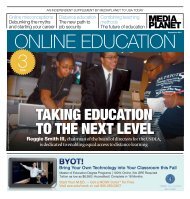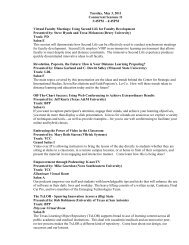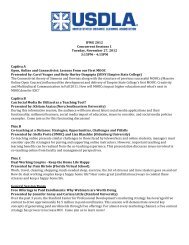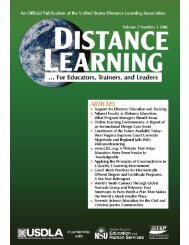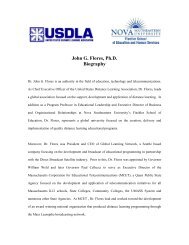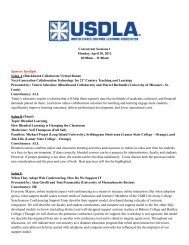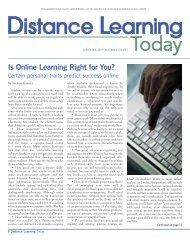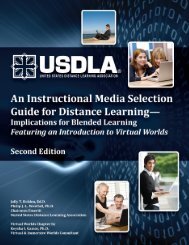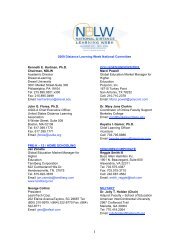United States Distance Learning Association
United States Distance Learning Association
United States Distance Learning Association
- No tags were found...
You also want an ePaper? Increase the reach of your titles
YUMPU automatically turns print PDFs into web optimized ePapers that Google loves.
CONSTITUENCIES IN<br />
DISTANCE EDUCATION<br />
Each constituency brings a different<br />
agenda to the table: the students, the<br />
administration, and the faculty. Harvey<br />
and Green (1993) contend that “this is not a<br />
different perspective on the same thing,<br />
but different perspectives on different<br />
things with the same label” (p. 9).<br />
FACULTY<br />
Many studies (Abel, 2005; Allen & Seaman,<br />
2003; American Federation of Teachers,<br />
2000; Perry, 2003; Puffer, 2005; Smith,<br />
2004; Sumrall, 2002; Twigg, 2001a; Zemsky<br />
& Massy, 2004) provide evidence of the<br />
perceptions of faculty about what constitutes<br />
quality in distance education. One of<br />
the reasons why distance education has<br />
not yet become mainstream lies in the faculty.<br />
Early adopters maintain that distance<br />
education has the ability to foster independent<br />
study, while laggards remain skeptical<br />
because they believe that “teaching and<br />
learning are inherently social processes,”<br />
where “‘same-time same-place’ interaction<br />
[is] central to a successful educational<br />
learning experience” (American Federation<br />
of Teachers, 2000, p. 5).<br />
For some faculty members, venturing<br />
online constitutes transferring the learning<br />
materials they have developed for traditional<br />
settings online (Weigel, 2000). Students,<br />
on the other hand, may have<br />
different expectations. In addition, there is<br />
no guarantee that students will take<br />
advantage of all the learning materials provided.<br />
Faculty may be adding a great variety<br />
of materials, but if some students do<br />
not take advantage of them, can this still be<br />
defined as quality distance education<br />
<strong>Learning</strong> needs to be a factor in measuring<br />
the quality of the education provided. As<br />
Zemsky and Massy (2004) contend, faculty<br />
must change the way they teach before e-<br />
learning becomes mainstream.<br />
Faculty may be resisting the move<br />
towards distance education for reasons<br />
that have nothing to do with academics.<br />
Aside from a new set of skills, preparing<br />
content for online delivery requires a huge<br />
investment of faculty time. The question<br />
remains as to how the institution will<br />
acknowledge such effort. In 1990, the Carnegie<br />
Foundation for the Advancement of<br />
Teaching (Boyer, 1990) proposed a model<br />
to reward teachers for more than just<br />
“good evaluations” and amount of<br />
research. According to this model, activities<br />
such as service to the school community<br />
and engagement in new projects<br />
promoted by the school should also be<br />
considered scholarship.<br />
Regardless of whether the course is<br />
taught face-to-face or at a distance, the<br />
teacher needs to be present both at the<br />
cognitive and at the social level (Beaudoin,<br />
2002, Haavind, 2004). It is the teacher’s<br />
responsibility to create a comfortable learning<br />
environment, where prompt feedback<br />
is the norm rather than the exception<br />
(Chickering & Ehrmann, 1996; Kirtley,<br />
2002).<br />
Faculty members have traditionally<br />
modified their teaching style and the mix<br />
of materials used based on student feedback.<br />
This is no different in distance education.<br />
Perry (2003) examined faculty beliefs<br />
about quality in distance education and<br />
their perceptions of what students believe<br />
about quality in distance education. The<br />
results of this study showed that faculty<br />
rated their beliefs about quality in distance<br />
education and other areas higher than<br />
they rated their perceptions of student<br />
beliefs in the same areas.<br />
STUDENTS<br />
Some studies (LaBonte, 2003; Mansouri,<br />
2003; Ortiz-Rodriguez et al., 2003; Shepperd,<br />
2002) have analyzed the perceptions<br />
of distance learners about what constitutes<br />
quality in distance education. Others have<br />
compared the perceptions of quality of<br />
online and traditional courses (Gottwald,<br />
2005; Moret, 2004).<br />
Volume 4, Issue 4 <strong>Distance</strong> <strong>Learning</strong> 23



